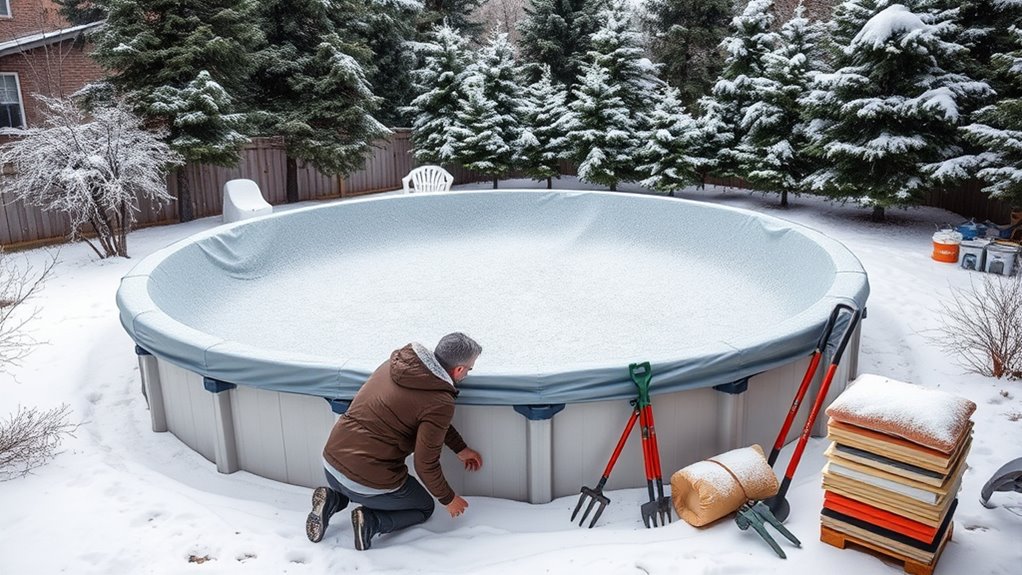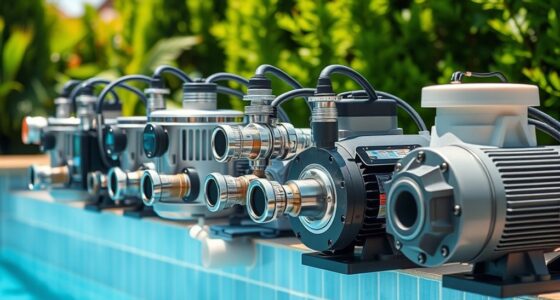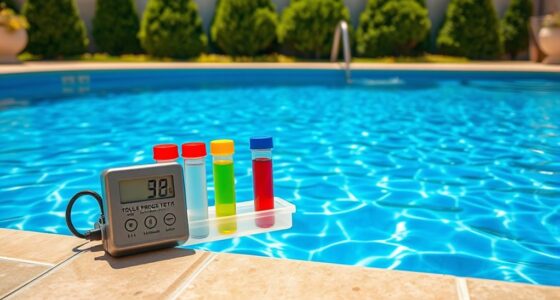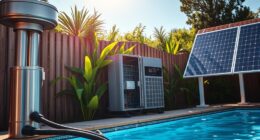To winterize your outdoor pool, you start by cleaning it thoroughly, removing debris, and balancing the chemicals to prevent algae and corrosion. Next, lower the water level, drain and blow out the plumbing lines, then add winter chemicals and cover the pool securely. Disconnect and store equipment, check the cover regularly, and guarantee everything is protected from freezing damage. Following these steps carefully will help you prepare your pool for a trouble-free off-season—discover more tips below.
Key Takeaways
- Clean the pool thoroughly, skim debris, vacuum, and balance chemical levels to prevent algae and stains.
- Lower water level below skimmer and jets, then add winter chemicals, including algaecides and clarifiers.
- Turn off the pump, disconnect equipment, and drain plumbing lines to prevent freezing damage.
- Cover the pool securely with a high-quality winter cover, ensuring it is tight and properly anchored.
- Store all equipment and chemicals in a dry, sheltered area, and regularly inspect the cover throughout winter.

As the weather starts to cool and the days grow shorter, it is essential to prepare your outdoor pool for winter. Properly winterizing your pool helps prevent damage from freezing temperatures and keeps it in good condition for the next swimming season. The first step is to clean your pool thoroughly, removing any debris, leaves, and dirt from the surface and the bottom. Use a net and a pool vacuum if necessary. Once the pool is clean, test and adjust the chemical balance. You want the pH to be around 7.2 to 7.6, alkalinity between 80 and 120 ppm, and calcium hardness at appropriate levels. Proper chemical balance prevents algae growth and corrosion during the off-season. You might need to add pH increasers or decreasers, alkalinity adjusters, and stabilizers. Run your pool filter to circulate the chemicals for at least 12 hours, ensuring even distribution.
Next, you’ll need to lower the water level, usually below the skimmer and return jets, to prevent freezing water from causing cracks or damage. Once the water level is adjusted, it’s time to add a winterizing chemical kit, which typically includes algaecides and clarifiers, to keep the water clear and free from algae during the months of disuse. After chemical treatment, turn off the pool pump and disconnect all equipment, including filters, skimmers, and heaters. Drain the plumbing lines completely to avoid freezing water pockets that could crack pipes. If you’re in a particularly cold climate, consider using a compressor or air blower to blow out any remaining water from the lines. Proper maintenance during this process ensures the longevity and optimal performance of your pool equipment.
Now, cover your pool securely with a high-quality pool cover. A sturdy, winter-grade cover helps keep debris out and protects your pool’s surface from harsh winter conditions. Make sure the cover fits tightly and is anchored properly to prevent it from slipping or blowing away in strong winds. Before covering, double-check that all chemicals are balanced, and the water is properly treated, to minimize algae growth and staining during the winter months. In colder climates, some owners opt to add a winter chemical floater underneath the cover to maintain proper chemical levels and prevent algae buildup.
Finally, inspect the area around your pool for any potential hazards or weak spots in the cover. Store all pool equipment in a dry, sheltered place. By following these steps carefully, you set your pool up for a smooth start come spring, avoiding costly repairs and ensuring your investment stays in excellent shape throughout the off-season. Proper winterization makes a significant difference in preserving your outdoor pool’s longevity and performance for years to come.
Frequently Asked Questions
When Is the Best Time to Winterize My Outdoor Pool?
You should winterize your outdoor pool during late fall, ideally before temperatures consistently stay below 50°F. Timing considerations are vital, so monitor your seasonal climate and aim to close your pool when the weather forecast predicts several consecutive cold nights. Doing it too early might prolong maintenance, while waiting too long risks damage from freezing water. Planning ahead guarantees your pool stays protected through winter.
Can I Winterize My Pool Without Draining All the Water?
Sure, you can winterize your pool without draining all the water—who wouldn’t want to skip that messy step? Just make certain you balance the chemicals properly and install a pool cover to keep debris out. Keep in mind, leaving water in could cause freezing issues, so double-check your local climate. Proper chemical balancing and a sturdy cover are your best bets for a hassle-free winter.
What Are the Signs My Pool Needs Winterization?
You’ll want to winterize your pool if you notice your water turning cloudy, algae growth, or increased debris, which indicate it needs protection. Check your chemical treatment levels and adjust them accordingly, and consider your pool cover options to keep out dirt and pests. These signs mean it’s time to prepare your pool for winter, ensuring it stays clean and safe until the warmer months return.
How Often Should I Check My Pool During Winter?
You should check your pool at least once a week during winter to keep up with winter maintenance. Tossing a glance at your pool cover, ensuring it’s secure, and checking for debris or ice buildup keeps things in check. Don’t let winter’s icy grip turn your pool into a frozen disaster. Regular inspections help prevent damage, save time, and make your spring start-up a breeze. Stay vigilant, and enjoy worry-free winter pool care.
Is Professional Winterization Necessary for Small Pools?
Professional winterization isn’t always necessary for small pools if you maintain a pool cover and keep the chemical balance correct. However, if you’re unsure about managing these tasks or live in an area with harsh winters, hiring a pro can guarantee your pool is properly prepared. They’ll ensure the cover is secure and the chemicals are balanced, preventing damage and making spring opening easier.
Conclusion
Now that you’ve winterized your outdoor pool, you’ve set the stage for a smooth start-up next season. Think of it as tucking your pool in for a cozy winter nap, ready to wake refreshed come spring. With these steps, you’ve safeguarded your investment and ensured many more seasons of splashes and swims. So, rest easy knowing your pool is snug and secure, waiting patiently like a bear in hibernation, until it’s time to make a splash again.









